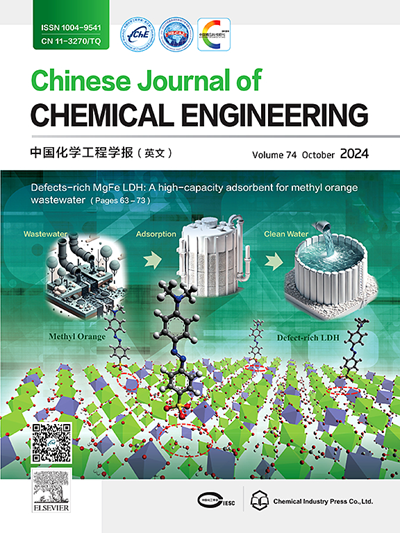Electrochemically reconstructed copper-polypyrrole modified graphite felt electrodes for efficiently electrocatalytic reduction of nitrate
IF 3.7
3区 工程技术
Q2 ENGINEERING, CHEMICAL
引用次数: 0
Abstract
In this work, a simple two-step electrodeposition was employed to prepare PPy-Cu/GF (PPy, polypyrrole; GF, graphite felt) composite cathodes for the nitrate reduction. Characterized results revealed that the introduction of PPy as an intermediate layer resulted in the transformation of both granular and dendritic Cu in form of Cu+/Cu0, Cu2+ on the electrode surface. The -N of 50 mg·L−1 was almost completely removed (99.01%) using the PPy-Cu/GF cathode under the optimum condition, which is obviously higher than the GF, PPy/GF and Cu/GF electrodes. -N removal was slightly affected over the pH scale of 3.0–11.0, whereas increasing the current density from 10 to 25 mA·cm−2 boosted the reduction of -N. At a Cl− concentration of 2000 mg·L−1, the removal of -N was slightly reduced, while the selectivity for N2 increased dramatically due to the active chlorine could oxidize -N to N2. Meanwhile, PPy-Cu/GF cathode exhibits an average removal rate of 97.83% within 12 cycles, highlighting its potential for application in actual water bodies. The EPR analysis and the active species trapping experiment confirmed that the nitrate reduction on the PPy-Cu/GF cathode mainly relies on direct reduction mediated by electron transfer, while ∗H influences the reduction of nitrite to ammonia.

电化学重建铜-聚吡咯改性石墨毡电极的高效电催化还原硝酸盐
本文采用简单的两步电沉积法制备了PPy- cu /GF (PPy,聚吡咯;GF(石墨毡)复合阴极用于硝酸还原。表征结果表明,在电极表面引入PPy作为中间层,导致颗粒态Cu和枝晶态Cu以Cu+/Cu0, Cu2+的形式转变。在最佳条件下,PPy-Cu/GF阴极对50 mg·L−1 NO3−-N的去除率达到99.01%,明显高于GF、PPy/GF和Cu/GF电极。pH在3.0 ~ 11.0范围内对NO3−-N的去除率影响较小,而当电流密度从10 mA·cm−2增加到25 mA·cm−2时,对NO3−-N的去除率有促进作用。当Cl−浓度为2000 mg·L−1时,由于活性氯能将NH4+-N氧化为N2, NO3−-N的去除率略有降低,而对N2的选择性显著提高。同时,py - cu /GF阴极在12个循环内的平均去除率为97.83%,显示了其在实际水体中的应用潜力。EPR分析和活性物种捕获实验证实,py - cu /GF阴极上的硝酸盐还原主要依赖于电子转移介导的直接还原,而∗H影响亚硝酸盐还原为氨。
本文章由计算机程序翻译,如有差异,请以英文原文为准。
求助全文
约1分钟内获得全文
求助全文
来源期刊

Chinese Journal of Chemical Engineering
工程技术-工程:化工
CiteScore
6.60
自引率
5.30%
发文量
4309
审稿时长
31 days
期刊介绍:
The Chinese Journal of Chemical Engineering (Monthly, started in 1982) is the official journal of the Chemical Industry and Engineering Society of China and published by the Chemical Industry Press Co. Ltd. The aim of the journal is to develop the international exchange of scientific and technical information in the field of chemical engineering. It publishes original research papers that cover the major advancements and achievements in chemical engineering in China as well as some articles from overseas contributors.
The topics of journal include chemical engineering, chemical technology, biochemical engineering, energy and environmental engineering and other relevant fields. Papers are published on the basis of their relevance to theoretical research, practical application or potential uses in the industry as Research Papers, Communications, Reviews and Perspectives. Prominent domestic and overseas chemical experts and scholars have been invited to form an International Advisory Board and the Editorial Committee. It enjoys recognition among Chinese academia and industry as a reliable source of information of what is going on in chemical engineering research, both domestic and abroad.
 求助内容:
求助内容: 应助结果提醒方式:
应助结果提醒方式:


